1997 CHEVROLET CORVETTE window
[x] Cancel search: windowPage 202 of 356
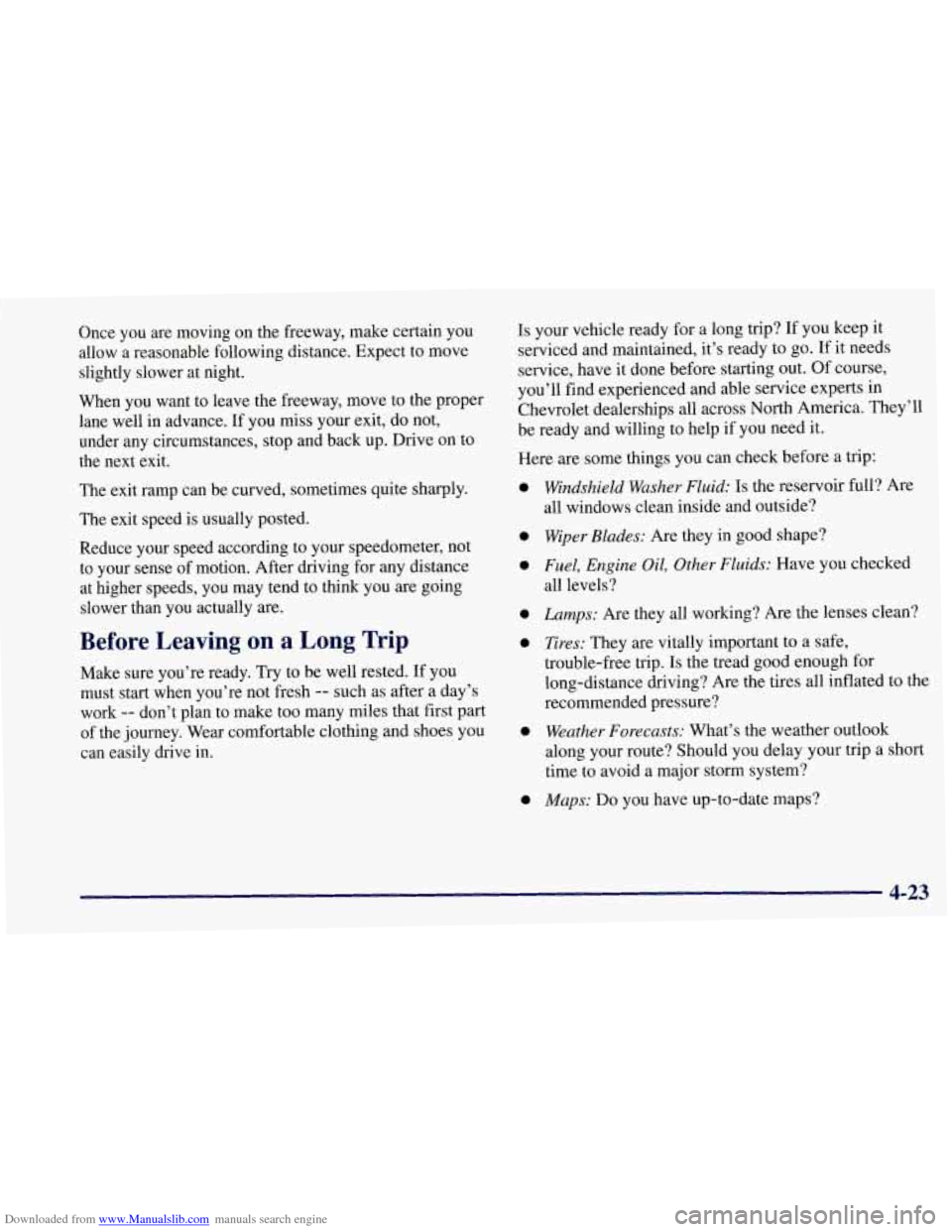
Downloaded from www.Manualslib.com manuals search engine Once you are moving on the freeway, make certain you
allow a reasonable following distance. Expect
to move
slightly slower at night.
When you want to leave the freeway, move to the proper
lane well in advance. If you miss your exit, do not,
under any circumstances, stop and back up. Drive on
to
the next exit.
The exit ramp can be curved, sometimes quite sharply.
The exit speed
is usually posted.
Reduce your speed according to your speedometer, not to your sense of moti0.n. After driving for any distance
at higher speeds, you may tend to think you are going
slower than you actually
are.
Before Leaving on a Long Trip
Make sure you’re ready. Try to be well rested. If you
must start when you’re not fresh
-- such as after a day’s
work
-- don’t plan to make too many miles that first part
of the journey. Wear comfortable clothing and shoes you
can easily drive in.
Is your vehicle ready for a long trip? If you keep it
serviced and maintained, it’s ready to go. If it needs
service, have it done before starting out. Of course,
you’ll find experienced and able service experts in
Chevrolet dealerships all across
North America. They’ll
be ready and willing to help if you need it.
Here are some things you can check before a trip:
0
0
0
0
0
0 0
Windshield Washer Fluid: Is the reservoir full? Are
all windows clean inside and outside?
Wiper Blades: Are they in good shape?
Fuel, Engine Oil, Other Fluids: Have you checked
all levels?
Lamps: Are they all working? Are the lenses clean?
Tires: They are vitally important to a safe,
trouble-free trip. Is the tread good enough for
long-distance driving?
Are the tires all inflated to the
recommended pressure?
Weather Forecasts: What’s the weather outlook
along your route? Should you delay your trip a short
time to avoid a major storm system?
Maps: Do you have up-to-date maps?
4-23
Page 208 of 356
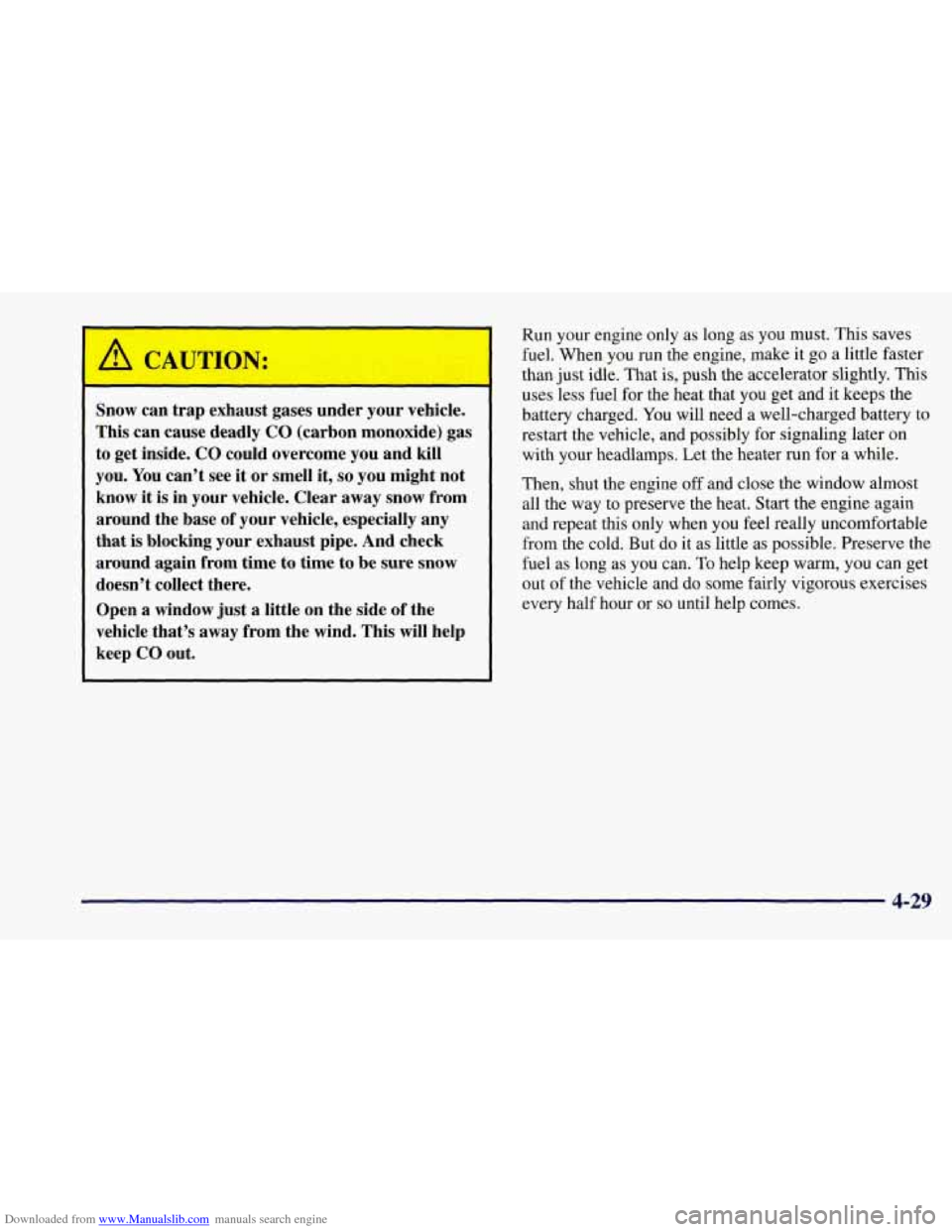
Downloaded from www.Manualslib.com manuals search engine Snow can trap exhaust gases under your vehicle.
This can cause deadly
CO (carbon monoxide) gas
to get inside.
CO could overcome you and kill
you. You can’t see it or smell it, so you might not
know it
is in your vehicle. Clear away snow from
around the base of your vehicle, especially any
that
is blocking your exhaust pipe. And check
around again from time to time to be sure
snow
doesn’t collect there.
Open a window just
a little on the side of the
vehicle that’s away from the wind. This will help
keep
CO out.
I Run your engine only as long as you must. This saves
fuel. When you run the engine, make it
go a little faster
than just idle. That is, push the accelerator slightly. This
uses less fuel for the heat that you get and it keeps the
battery charged. You will need a well-charged battery to
restart the vehicle, and possibly for signaling later on
with your headlamps. Let the heater run for a while.
Then, shut the engine off and close the window almost
all the way to preserve the heat. Start the engine again
and repeat this only when you feel really uncomfortable
from the cold. But do
it as little as possible. Preserve the
fuel as long
as you can. To help keep warm, you can get
out of the vehicle and do some fairly vigorous exercises
every half hour
or so until help comes.
4-29
Page 226 of 356
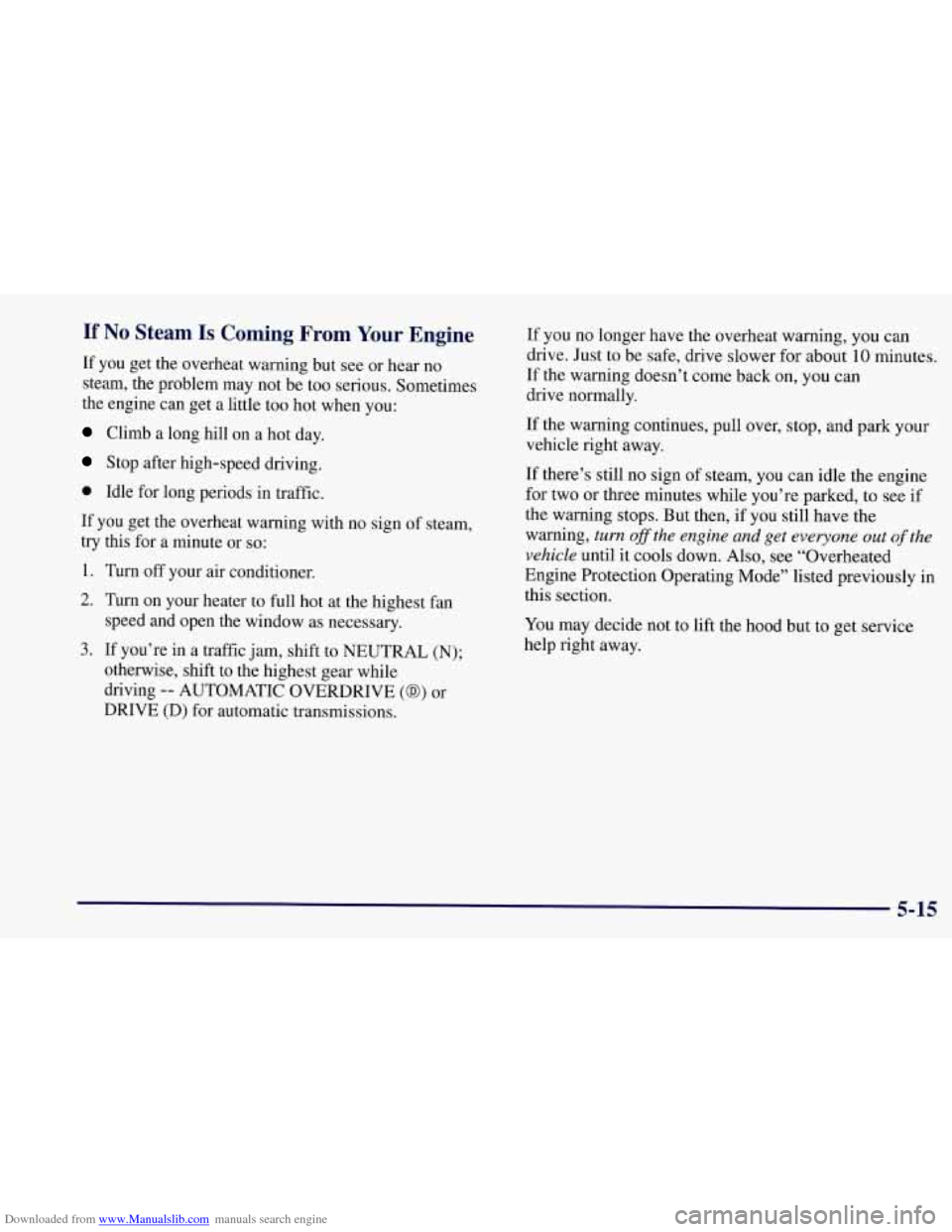
Downloaded from www.Manualslib.com manuals search engine If No Steam Is Coming From Your Engine
If you get the overheat warning but see or hear no
steam, the problem may not be too serious. Sometimes
the engine can get a little too hot when you:
Climb a long hill on a hot day.
Stop after high-speed driving.
0 Idle for long periods in traffic.
If you get the overheat warning with no sign of steam,
try this for a minute or
so:
1.
2.
3.
Turn off your air conditioner.
Turn on your heater to full hot at the highest fan
speed and open the window as necessary.
If you’re in a traffic jam, shift to NEUTRAL
(N);
otherwise, shift to the highest gear while
driving
-- AUTOMATIC OVERDRIVE (@) or
DRIVE (D) for automatic transmissions. If you
no longer have the overheat warning, you can
drive. Just to be safe, drive slower for about
10 minutes.
If the warning doesn’t come back on, you can
drive normally.
If the warning continues, pull over, stop, and park your
vehicle right away.
If there’s still no sign of steam, you can idle the engine
for two or three minutes while you’re parked, to see if
the warning stops. But then, if you still have the
warning,
turn ofthe engine and get everyone out of the
vehicle
until it cools down. Also, see “Overheated
Engine Protection Operating Mode” listed previously in
this section.
You may decide not to lift the hood
but to get service
help right away.
5-15
Page 286 of 356
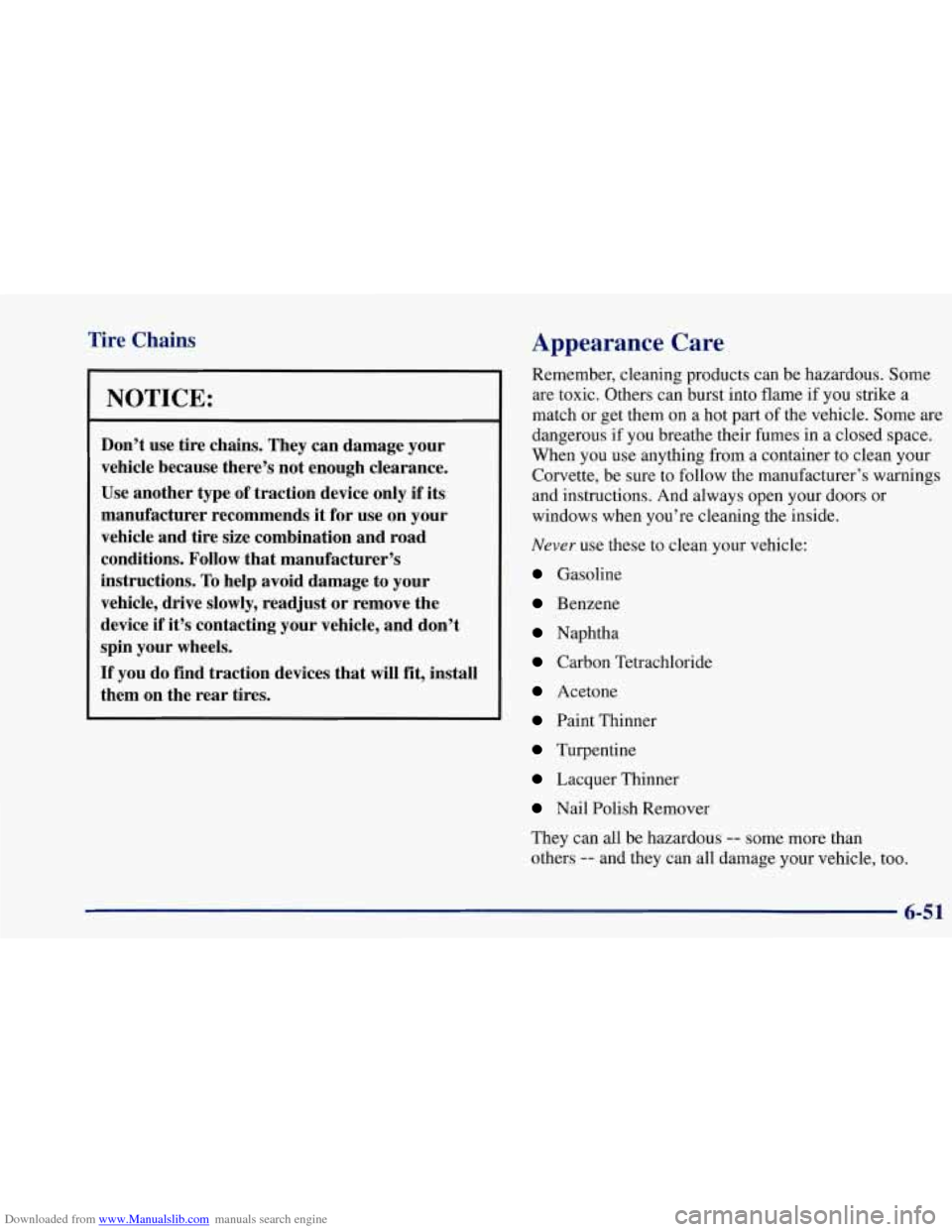
Downloaded from www.Manualslib.com manuals search engine Tire Chains
NOTICE:
Don’t use tire chains. They can damage your
vehicle because there’s not enough clearance.
Use another type of traction device only
if its
manufacturer recommends it for use on your
vehicle and tire size combination and road
conditions. Follow that manufacturer’s
instructions.
To help avoid damage to your
vehicle, drive slowly, readjust or remove the
device
if it’s contacting your vehicle, and don’t
spin your wheels.
If you do find traction devices that will fit, install
them on the rear tires.
Appearance Care
Remember, cleaning products can be hazardous. Some
are toxic. Others can burst into flame if you strike a
match or get them
on a hot part of the vehicle. Some are
dangerous if you breathe their fumes in a closed space.
When you use anything from a container to clean your
Corvette, be sure to follow the manufacturer’s warnings
and instructions. And always open your doors or
windows when you’re cleaning the inside.
Never use these to clean your vehicle:
Gasoline
Benzene
Naphtha
Carbon Tetrachloride
Acetone
Paint Thinner
Turpentine
Lacquer Thinner
Nail Polish Remover
They can all be hazardous
-- some more than
others
-- and they can all damage your vehicle, too.
6-51
Page 289 of 356
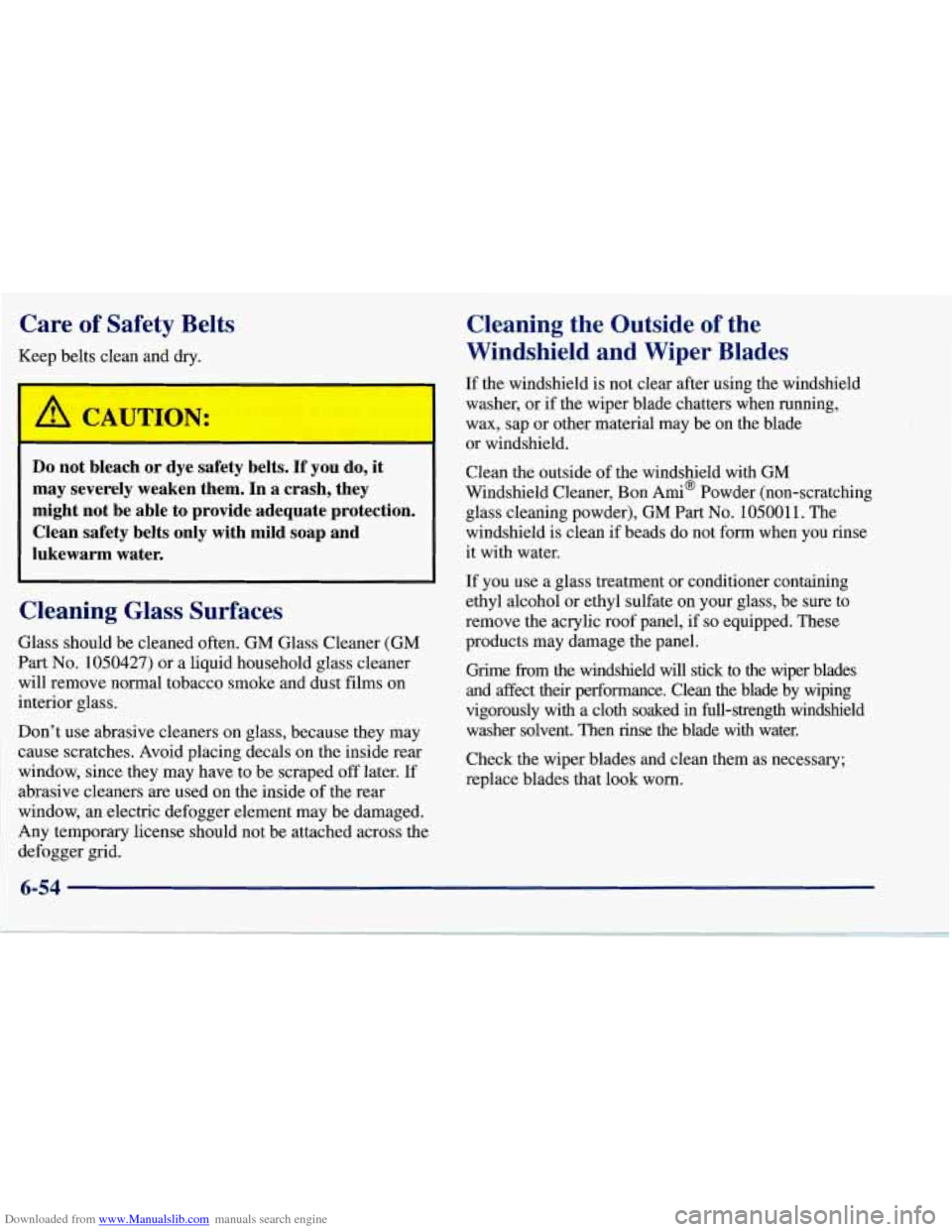
Downloaded from www.Manualslib.com manuals search engine Care of Safety Belts
Keep belts clean and dry.
Do not bleach or dye safety belts. If you do, it
may severely weaken them. In a crash, they
might not
be able to provide adequate protection.
Clean safety belts only with mild soap and
lukewarm water.
Cleaning Glass Surfaces
Glass should be cleaned often. GM Glass Cleaner (GM
Part No. 1050427) or a liquid household glass cleaner
will remove normal tobacco smoke and dust films on
interior glass.
Don’t use abrasive cleaners on glass, because they may
cause scratches. Avoid placing decals on the inside rear
window, since they may have to be scraped
off later. If
abrasive cleaners are used on the inside of
the rear
window, an electric defogger element may be damaged.
Any temporary license should not be attached across the defogger grid.
Cleaning the Outside of the
Windshield and Wiper Blades
If the windshield is not clear after using the windshield
washer, or if the wiper blade chatters when running,
wax, sap or other material may be on the blade
or windshield.
Clean the outside of the windshield with GM
Windshield Cleaner, Bon
Ami@ Powder (non-scratching
glass cleaning powder), GM
Part No. 1050011. The
windshield is clean if beads do not form when you rinse
it with water.
If you use a glass treatment or conditioner containing
ethyl alcohol or ethyl sulfate on your glass, be sure to
remove the acrylic roof panel, if
so equipped. These
products may damage the panel.
Grime
horn the windshield will stick to the wiper blades
and affect their performance. Clean the blade by wiping
vigorously with a cloth
soaked in full-strength windshield
washer solvent. Then rinse the blade
with water.
Check the wiper blades and clean them as necessary;
replace blades that look worn.
Page 297 of 356
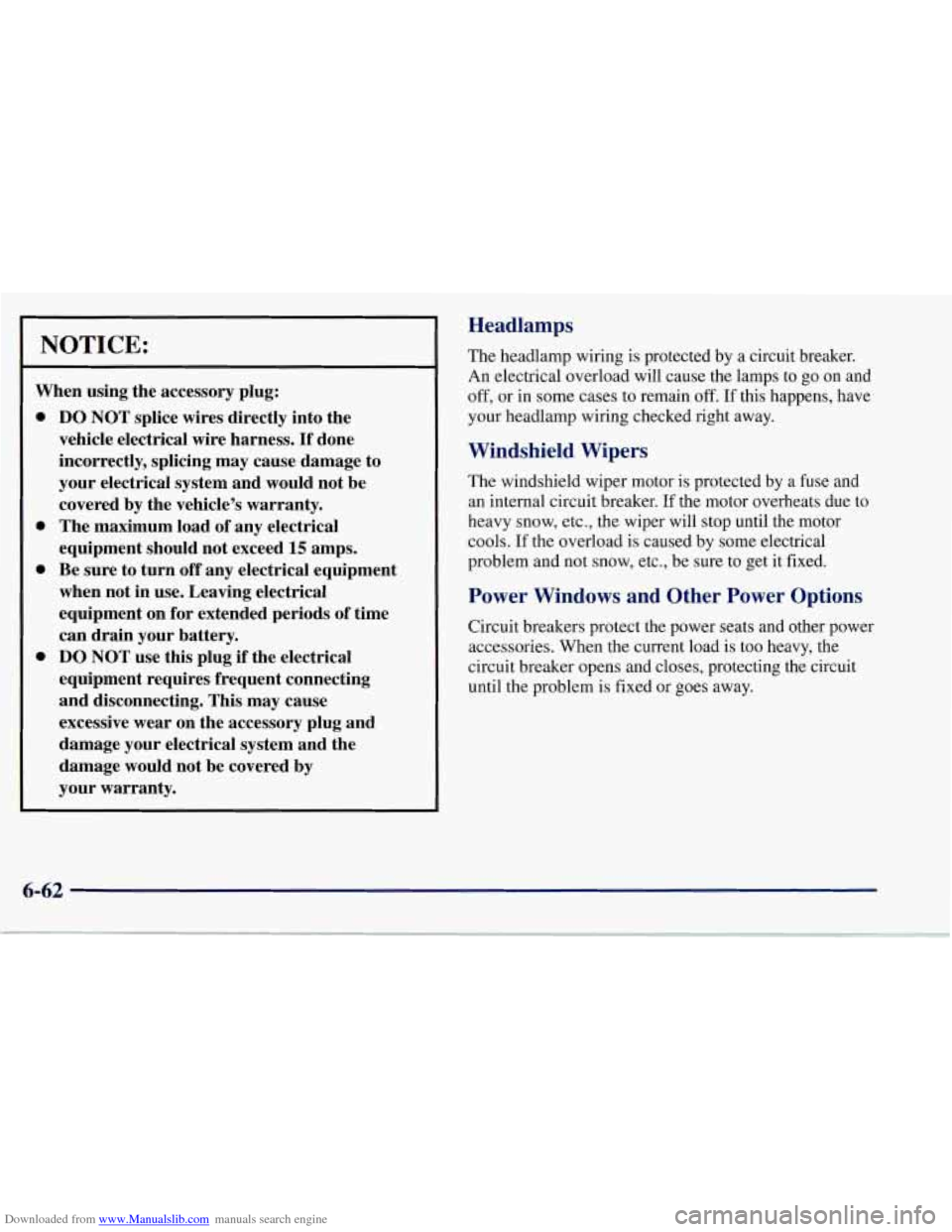
Downloaded from www.Manualslib.com manuals search engine NOTICE:
When using the accessory plug:
0
0
0
0
DO NOT splice wires directly into the
vehicle electrical wire harness.
If done
incorrectly, splicing may cause damage to
your electrical system and would not be
covered by the vehicle’s warranty.
The maximum load of any electrical
equipment should not exceed
15 amps.
Be sure to turn off any electrical equipment
when not in use. Leaving electrical
equipment on for extended periods of time
can drain your battery.
DO NOT use this plug if the electrical
equipment requires frequent connecting
and disconnecting. This may cause
excessive wear on the accessory plug and
damage your electrical system and the
damage would not be covered by
your warranty.
Headlamps
The headlamp wiring is protected by a circuit breaker.
An electrical overload will cause the lamps to go on and
off, or in some cases to remain off. If this happens, have
your headlamp wiring checked right away.
Windshield Wipers
The windshield wiper motor is protected by a fuse and
an internal circuit breaker.
If the motor overheats due to
heavy snow, etc., the wiper will stop until the motor
cools. If the overload
is caused by some electrical
problem and not snow, etc., be sure to get
it fixed.
Power Windows and Other Power Options
Circuit breakers protect the power seats and other power
accessories. When the current load is too heavy, the
circuit breaker opens and closes, protecting the circuit
until the problem is fixed or goes away.
6-62
Page 346 of 356
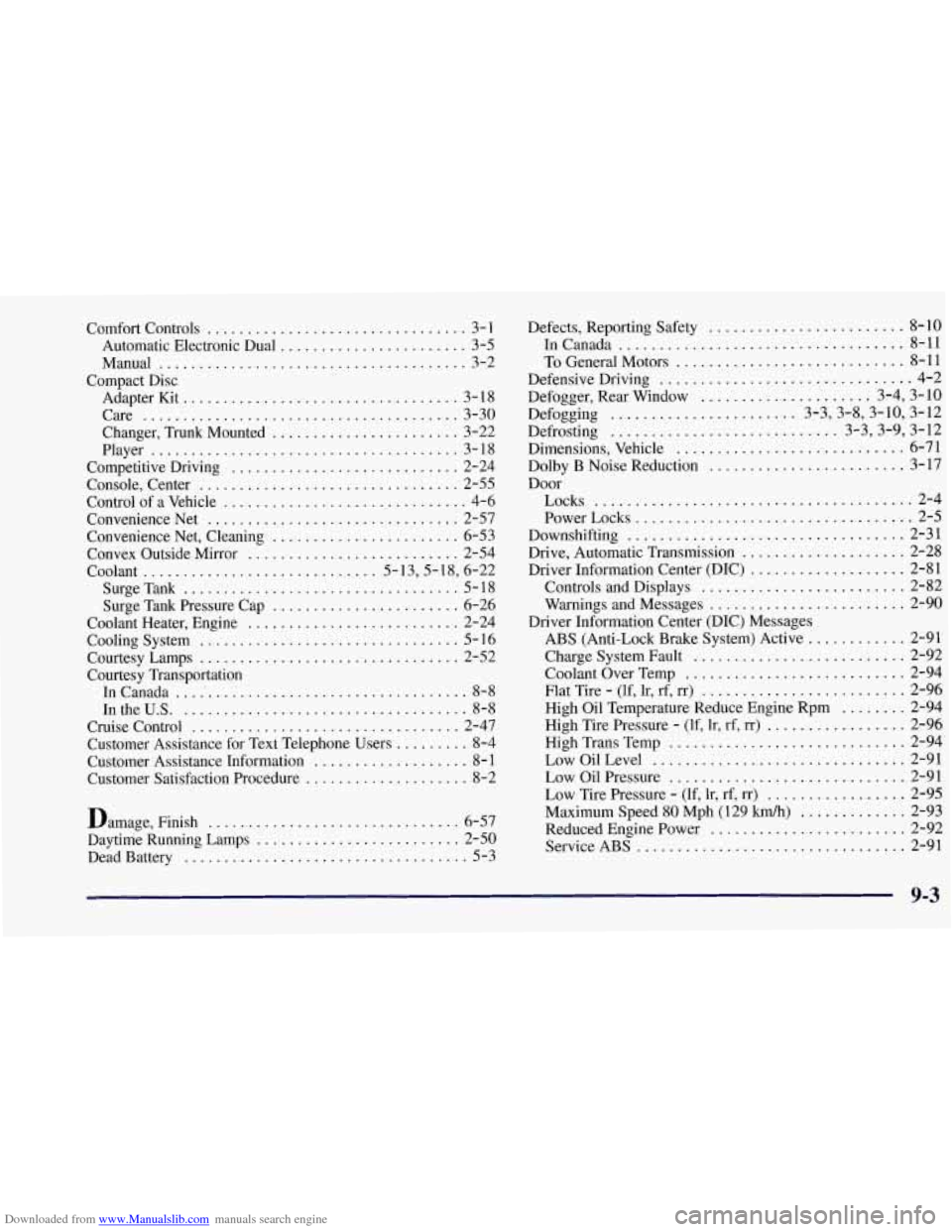
Downloaded from www.Manualslib.com manuals search engine Comfort Controls ................................ 3- 1
Automatic Electronic Dual ....................... 3-5
Manual
...................................... 3-2
Adapter Kit
.................................. 3-18
Care
....................................... 3-30
Changer, Trunk Mounted
....................... 3-22
Player
...................................... 3-18
Competitive Driving ............................ 2-24
Console, Center
................................ 2-55
Control of a Vehicle
.............................. 4-6
Convenience Net
............................... 2-57
Convenience Net, Cleaning
....................... 6-53
Convex Outside Mirror
.......................... 2-54
Coolant
............................. 5-13,5-18, 6-22
SurgeTank
.................................. 5-18
Surge Tank Pressure Cap
....................... 6-26
Coolant Heater, Engine
.......................... 2-24
Cooling System
................................ 5- 16
CourtesyLamps
................................ 2-52
Courtesy Transportation
In Canada
..................................... 8-8
1ntheU.S. ................................... 8-8
Cruise Control ................................. 2-47
Customer Assistance for Text Telephone Users
......... 8-4
Customer Assistance Information
................... 8- 1
Customer Satisfaction Procedure .................... 8-2
Compact Disc
Damage. Finish
............................... 6-57
Daytime Running Lamps
......................... 2-50
Dead Battery
................................... 5-3 Defects. Reporting Safety
........................ 8-10
InCanada
................................... 8-11
To General Motors ............................ 8-11
Defensive Driving
............................... 4-2
Defogger. Rear Window
..................... 3.4. 3.10
Defogging
....................... 3.3.3.8.3.10. 3.12
Defrosting
............................ 3.3.3.9. 3.12
Dimensions. Vehicle
............................ 6-71
Dolby
B Noise Reduction ........................ 3-17
Door Locks
....................................... 2-4
PowerLocks
.................................. 2-5
Downshifting
.................................. 2-31
Drive, Automatic Transmission
.................... 2-28
Driver Information Center (DIC)
................... 2-81
Controls and Displays
......................... 2-82
Warnings and Messages
........................ 2-90
ABS (Anti-Lock Brake System) Active
............ 2-91
Charge System Fault
.......................... 2-92
Coolant Over Temp
........................... 2-94
Flat Tire
- (If, lr, rf, rr) ......................... 2-96
High Oil Temperature Reduce Engine Rpm
........ 2-94
High Tire Pressure
- (If. Ir, rf. IT) ................. 2-96
High Trans Temp
............................. 2-94
LowOilLevel
............................... 2-91
Low Oil Pressure
............................. 2-91
Low Tire Pressure
- (If, lr. rf, rr) ................. 2-95
Maximum Speed 80 Mph (129
Mh) ............. 2-93
Reduced Engine Power
........................ 2-92
Service ABS
................................. 2-91
Driver Information Center
(DIC) Messages
9-3
Page 347 of 356
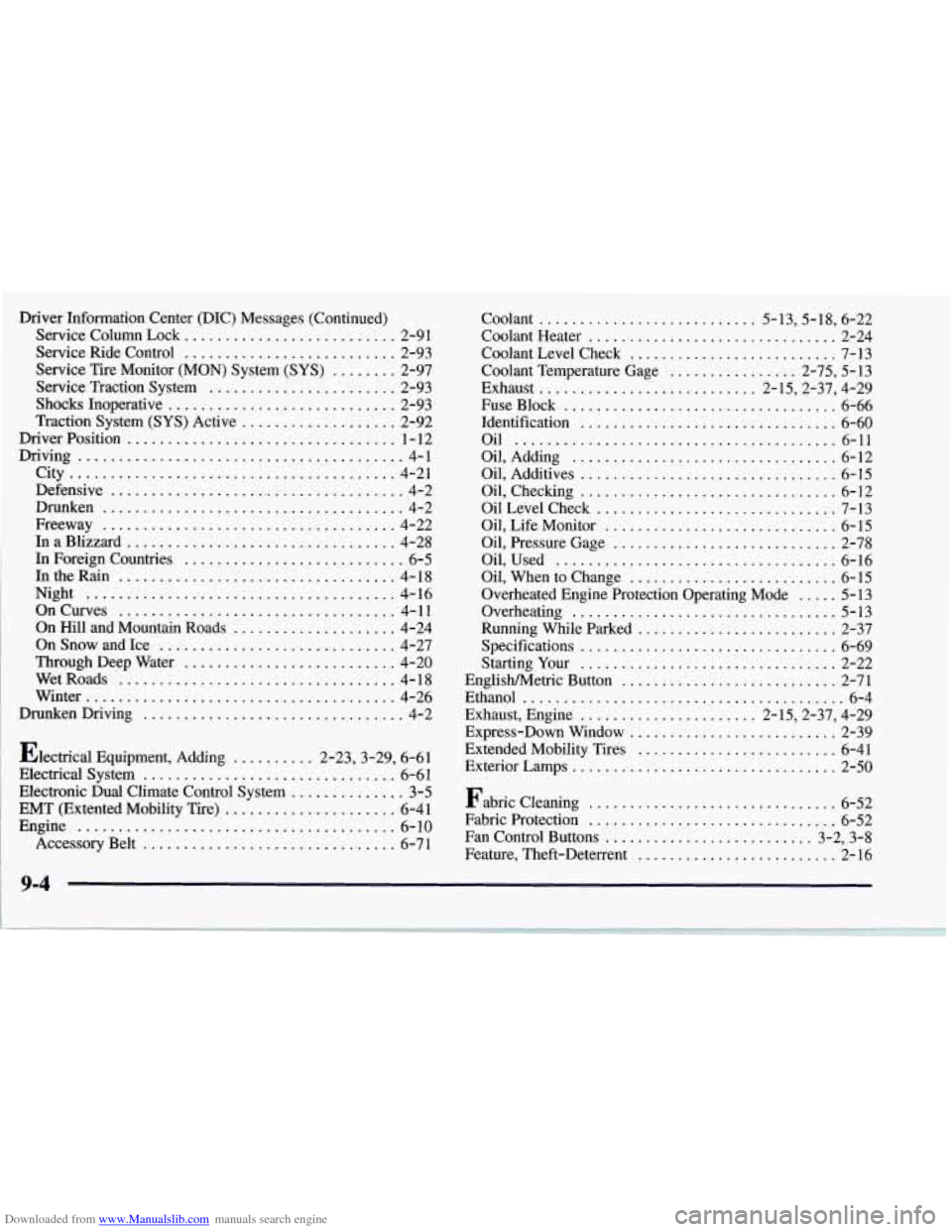
Downloaded from www.Manualslib.com manuals search engine Driver Information Center (DIC) Messages (Continued)
Service Column Lock
.......................... 2-91
Service Ride Control
.......................... 2-93
Service Tire Monitor (MON) System
(SYS) ........ 2-97
Service Traction System
....................... 2-93
Shocks Inoperative
............................ 2-93
Traction System
(SYS) Active ................... 2-92
Driving
........................................ 4-1
DriverPosition
................................. 1-12
City
........................................ 4-21
Defensive
.................................... 4-2
Drunken
..................................... 4-2
Freeway
.................................... 4-22
InaBlizzard
................................. 4-28
In Foreign Countries
........................... 6-5
In the Rain
.................................. 4- 18
Night
...................................... 4-16
OnCurves .................................. 4-11
On Hill and Mountain Roads .................... 4-24
On Snow and Ice
............................. 4-27
Through Deep Water
.......................... 4-20
WetRoads
.................................. 4-18
Winter
...................................... 4-26
Drunken Driving
................................ 4-2
Electrical Equipment. Adding
.......... 2-23,3-29, 6-61
Electrical System
............................... 6-61
Electronic Dual Climate
Control System .............. 3-5
EMT (Extented Mobility Tire)
..................... 6-41
Engine
....................................... 6-10
AccessoryBelt
............................... 6-71 Coolant
........................... 5.13.5.18. 6.22
Coolant Heater
............................... 2-24
Coolant Level Check
.......................... 7-13
Coolant Temperature Gage
................ 2.75. 5. 13
Exhaust
........................... 2.15.2.37. 4.29
FuseBlock
.................................. 6-66
Identification
................................ 6-60
Oil
........................................ 6-11
Oil, Adding
................................. 6-12
Oil, Additives
................................ 6-15
Oil. Checking
................................ 6-12
OilLevelCheck .............................. 7-13
Oil, Life Monitor
............................. 6-15
Oil, Pressure Gage
............................ 2-78
Oil, Used
................................... 6-16
Oil, When to Change
.......................... 6-15
Overheated Engine Protection Operating Mode
..... 5-13
Overheating
................................. 5-13
Running While Parked
......................... 2-37
Specifications
................................ 6-69
StartingYour
................................ 2-22
EnglishMetric Button
........................... 2-71
Ethanol
........................................ 6-4
Exhaust, Engine
...................... 2-15,2-37, 4-29
Express-Down Window
.......................... 2-39
Extended Mobility Tires
......................... 6-41
Exterior Lamps
................................. 2-50
Fabric Protection
............................... 6-52
Fan Control Buttons
.......................... 3-2, 3-8
Feature, Theft-Deterrent ......................... 2-16
Fabric
Cleaning
............................... 6-52